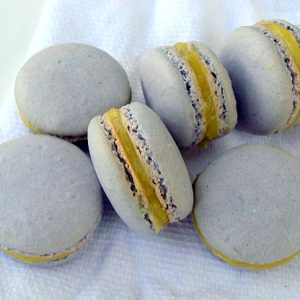Ingredients
Scale
- 4 ounces (115g) blanched almonds (or almond flour / whatever nut you like)
- 8 ounces (230g) powdered sugar*
- 5 ounces egg whites, room temperature
- 2 ½ ounce (72g) sugar
- the scrapings of 1 vanilla bean (r 2 tsp vanilla extract)
- ¼ teaspoon salt
- 1 tablespoon dried lavender
- Lavender colored gel paste
For the lemon curd
- 3 eggs
- 1 cup sugar
- ½ cup fresh lemon juice
- ¼ cup butter or margarine, melted
- 1 tablespoon grated lemon peel
Instructions
- Preheat the oven to 300° and have ready a large (18”) pastry bag, fitted with a plain tip, along with two sheet pans lined with parchment paper.
- If you’re using pre-made almond flour, simply sift with powdered sugar and set aside.
- Otherwise, process the almonds, lavender and powdered sugar for about a minute in your food processor. Take out the mixture and sift it, reserving whatever bits don’t pass through the sieve. Add these bits back to the food processor and run the machine for another minute. Sift again. You should have about 2 Tbsp of slightly chunkier almond bits; just add those into the dry mix.
- In the bowl of a (clean & dry!) stand mixer, combine the egg whites, sugar, vanilla bean (not the extract), and salt and turn the mixer to medium (4 on a Kitchen Aid). Whip for 3 minutes.
- Increase the speed to medium-high (7 on a Kitchen Aid) and whip another 3 minutes, then crank the speed to 8 for go another 3 minutes.
- At that point, turn the mixer off and add in vanilla extract and lavender color gel and whip for a final minute on the highest speed, just to show it who’s boss (and to evenly distribute the color/flavor).
- At the end of this minute, you should have a very stiff, dry meringue. (Check out this photo if you’d like to see a picture of how your meringue should look.) When you remove the whisk attachment, there will be a big clump of meringue in the center, just knock the whisk against the bowl to free it.
- Dump the dry ingredients into your meringue all at once and fold them in. Use both a folding motion (to incorporate the dry ingredients) and a pressing motion, to deflate the meringue against the side of the bowl.
- First timers: at first, the dry ingredients/meringue will look hopelessly incompatible. After about 25 turns the mixture will still have a quite lumpy and stiff texture. Another 15 strokes will see you to “just about right.” Keep in mind that macaronage is about deflating the whites, so don’t feel like you have to baby them.
- Undermixed macaron batter: quite stiff. If you spoon some out and drop it back into the mix, it will just sit there and never incorporate. Keep going.
- Overmixed macaron batter: has a runny, pancake batter-like texture. It will ooze continuously, making it impossible to pipe into pretty circles. You don’t want this to happen…
- I continuously check by batter after hitting the 30-stroke mark by doing a few turns and spooning some out, dropping it in, and counting to 30. If it isn’t mostly reincorporated in 30 seconds, keep going and test it again.
- Essentially, the macaron batter needs enough thickness that it will mound up on itself, but enough fluidity that after 20 seconds, it will melt back down.
- Transfer about half the batter to a piping bag. (Don’t fill your bag too full or it will be hard to control the amount that comes out). When piping, hold the bag as vertically as possible to make sure you get a round shape, rather than the slightly oval shape that will result if you hold the bag at an angle.
- Pipe the batter into circles on the baking sheet. Stop piping just shy of how big you want them, they will spread a bit.
- Bake for 10-18 minutes, depending on how big you made them, cool thoroughly, then peel the cooled macarons from the parchment, using a metal spatula if needed.
- Fill a pastry bag fitted with the lemon curd (recipe below) and pipe a quarter sized mound of buttercream into half of the shells, then sandwich them with their naked halves.
- Macarons, against all pastry traditions, actually get better with age. The shells soften and become more chewy, mingling with the flavor of the curd too. So, while of course you can eat them right away, don’t hesitate to store them refrigerated for up to a week.
For the lemon curd
- Whisk together all ingredients. Microwave for one minute, stir. Repeat until curd is thick enough to coat the back of a spoon. (It took me about 3 minutes). If you overcook, sieve the mixture to get rid of the bits of cooked egg. Refrigerate until thick and cold before using on macarons.
Keywords: macaroons, dessert, lavendar, lemon, cookies, pastry, lemon curd
